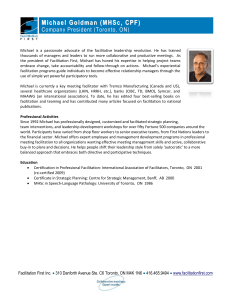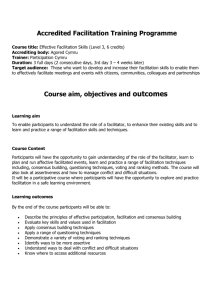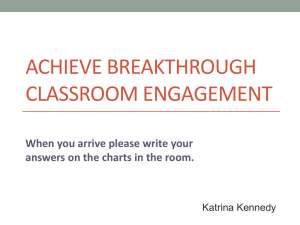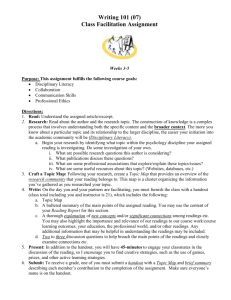Classroom Management or Facilitation 1 Running Head
advertisement
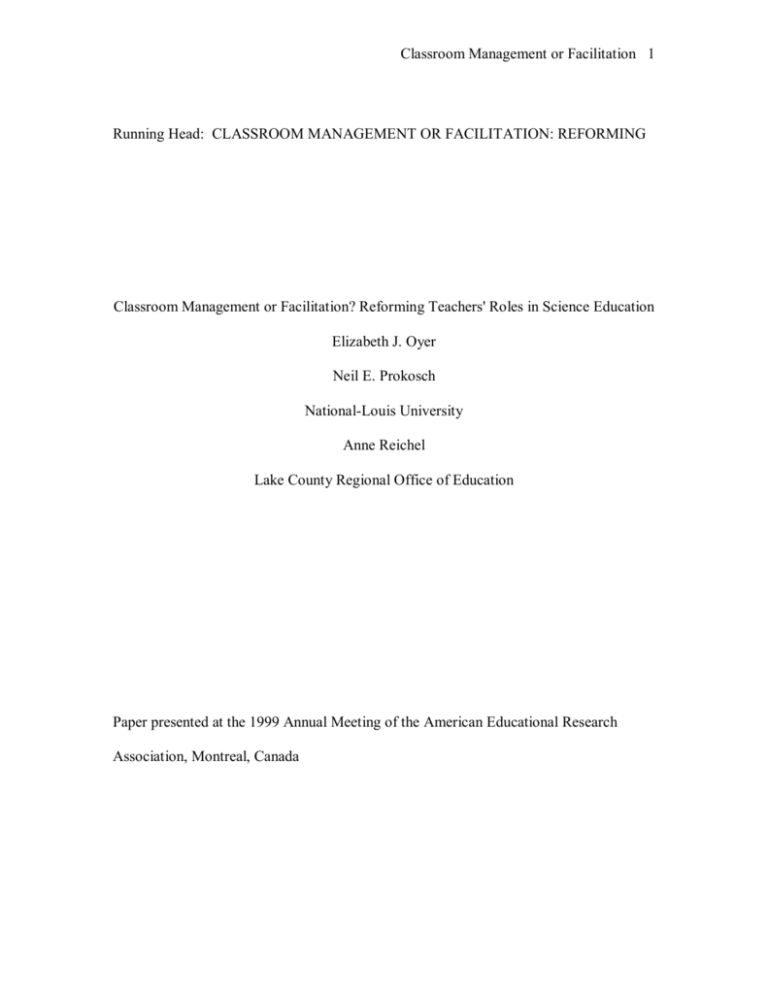
Classroom Management or Facilitation 1 Running Head: CLASSROOM MANAGEMENT OR FACILITATION: REFORMING Classroom Management or Facilitation? Reforming Teachers' Roles in Science Education Elizabeth J. Oyer Neil E. Prokosch National-Louis University Anne Reichel Lake County Regional Office of Education Paper presented at the 1999 Annual Meeting of the American Educational Research Association, Montreal, Canada Classroom Management or Facilitation 2 Classroom Management or Facilitation? Reforming Teachers' Roles in Science Education You're walking down the hall of a mid-sized, suburban school. You hear yelling and commotion coming from one of the classrooms. You peek in and see clusters of students scattered throughout the room. It appears they are constructing parachutes from scrap cloth. As you walk around the room, you notice that each cluster of students seems to be constructing the parachute differently. And they don't seem to have clear guidelines for how to create a parachute properly. As you watch, you see the students negotiating with each other to determine the design of the chute as well as ways to test it. Finally, after several revisions, most groups seem to have working parachutes floating through the air. In all this activity, the teacher is walking around the room answering student questions and providing materials when needed. She is clearly not in control of this learning exercise. You wonder to yourself what has become of science education as you walk back through the halls in search of a normal classroom. Science education has taken a turn. "Hands-on" or "discovery learning" activities have been replaced with more authentic, student-centered problems that are less structured and less teacher-directed. Whether its called Problem-based Learning or Technological Design, one theme seems clear: constructivism has become a driving force in science education. In support of this trend, the National Research Council recommends a de-emphasis of "student acquisition of information" and teacher "present(ation of) scientific knowledge through lecture, text, and demonstration" (Kahle, 1996, p. 274). In turn, the Council endorses more emphasis on "student understanding and use of…inquiry processes," as well as "guiding…students in active…scientific inquiry" (p. 274). These recommendations are consistent with the learning principles of constructivism as well as Classroom Management or Facilitation 3 their application through problem-based learning activities (Gallagher, Sher, Stepien, & Workman, 1995). It is still unclear whether intentions to promote student-centered learning have been effectively translated into practice (Finson, Fitch, Lisowski, & Foster, 1996). This application of constructivist learning theory into living, breathing science classrooms has proven problematic and complicated to say the least (Davis & Sumara, 1997). Recent research and discussions concerning constructivist-based science curricula have explored student attitudes, specific cognitive models for student learning, and limitations of the learning theory for science education (Weaver, 1998; Appleton, 1997; Osborne, 1996). Consideration of what management of the constructivist classroom "looks like" is an important component in the development of reforms in teacher preparation. Consider constructivism as a theory of learning. Constructivism presents a particular view of the relevant characteristics of the learner as well as the learning process. von Glaserfeld (1989) identified three themes in the constructivist view of knowledge: knowledge as individual, knowledge as constructed, and knowledge as resulting from social interaction. Piaget has been a pioneer in this conceptualization of the learner as an active agent who creates knowledge rather than a passive recipient of information. But more than just a philosophy for guiding instruction, constructivism is a theory of knowing with specific assertions about the nature of the student as knowledgemaker and the process of learning in general. But where does the teacher fit into this "new" science learning environment? Vygotsky's (1978) conception of the zone of proximal development explains the importance of teacher-student and student-student learning relationships. Basically, the zone is the difference between the learner's actual Classroom Management or Facilitation 4 developmental level and his/her potential or future development "as determined through problem solving under adult guidance or in collaboration with more capable peers" (p. 86). When the learner is given support by the teacher, he/she is able to accomplish understandings that would be impossible without this scaffolding. The above characterization of the learner and learning process has important implications on the design of instruction, which includes, of course, classroom management issues. So, what are the implications of constructivism on teaching and classroom management methods for teachers? One effect is found in the change of the teacher's role in the class from expert knowledge-transmitter and student "manager" to co-constructor and guider. Some of the specific changes in the classroom environment built on constructivism can be seen in instructional principles provided by Savery and Duffy (1995). First, all learning activities are anchored to a larger task or problem. Additionally, constructivist instruction fosters the development of the learner's ownership of the overall instructional goals (Savery & Duffy, 1995). And finally, learners are encouraged to test their ideas against alternatives. This principle comes from the notion that knowledge, as socially-negotiated, "can only be determined in a social environment where...the issues and views of others" are accommodated (Savery & Duffy, 1995, p. 6). These principles guide the design of the learning environment and the instruction and student management provided in that environment. Dana, Campbell, & Lunetta (1997) describe the changing nature of teacher competencies in these constructivist learning environments. "Teachers must shift their attention away from themselves as effective presenters of scientific information toward a focus on students' developmental needs to learn science with understanding" (p. 424). Hand (1996) documents this shift as teachers Classroom Management or Facilitation 5 in his study transition through five stages, from "managers" to "facilitators" and "empowerers" (p.217). In Stage 1 (Manager Role), teachers focus on information transfer; their main concerns are about classroom control. In Stage 2, teachers begin to recognize the mismatch between students' and teacher's conceptions of a topic or problem. Stage 3 (Technician Role) teachers focus on following implementation process for constructivist approach rather than on the effects of this approach on students' learning. Stage 4 (Facilitator Role) teachers have increased confidence in the constructivist approach resulting in a decrease in teacher-controlled activities. Finally, in Stage 5, teachers allow students to become problem-setters, not just problem-solvers. This is the role of the "empowerer" (pp. 216-219). This paper will focus on one project funded by the Illinois State Board of Education designed to promote the implementation of technological design as defined in the National Science Education Standards. These standards include the practice of identifying simple problems, proposing solutions, implementing proposed solutions, evaluating products or designs, and communicating design solutions. The staff development model utilized for this project promotes the use of technological design projects to enhance scientific literacy of students in grades 3 through 5. The discussion will focus on three general teacher role and classroom management issues that emerge in the technological design classroom: 1. How do teachers make sense of their new roles as "facilitators" rather than "managers" of classroom activities? 2. How do teachers differ in their transitions from "managers" to "facilitators" of classroom activities? Classroom Management or Facilitation 6 3. What are the "new" guidelines for teacher preparation in classroom management? Method Sample The application of technological design principles in 11 classrooms was assessed through classroom observation and interviews. Teachers' classrooms were visited while students were engaged in the design, construction and fair testing of the design projects. Both the teacher and students were observed to determine their instructional, learning, and non-instructional activities. Reflection on various issues related to the implementation of technological design was obtained in interviews of two teachers. Data Sources The observation instrument utilized fixed categories codes to record teacher instructional and non-instructional activities as well as student learning, non-learning and off task codes. The material used by the teacher and students were also coded. The activity and material codes reflected both general activities (lecture, discussion, questioning, etc.) and project specific activities (discovery, problem solving, critical thinking, design project material, etc). These codes provided a scaffold for reflecting on the classroom management issues faced in the technological design curriculum. Codes of teacher and student activities were recorded at 5 minute intervals through the observation. At each interval a visual clockwise sweep of the classroom was made and the activities of the teacher and each student was recorded using the codes. These codes were entered on a sketch of the classroom to indicate the location of the teacher and students as well as the activity that occurred. Between the sweeps, narrative Classroom Management or Facilitation 7 comments were recorded to assist in the analysis and interpretation of the data. These comments provided a context for the individual codes that were recorded. Finally, interviews were conducted with two teachers who approached the implementation of technological design differently (while still within the parameters of the design guidelines). These teachers' reflections were recorded, transcribed, and analyzed to identify loose themes in their understandings of classroom management issues, among other topics, in a technological design classroom. Data Analysis Frequency of student and teacher behaviors were tabulated for each coded activity by the researcher who conducted the observations. Analysis of interview data was conducted separately by the first author, who was not present in the field. Validity of themes emerging from qualitative analysis was triangulated with coded observations and member check with the researcher who conducted the observations. Results Teacher and student activity codes were tallied to determine the percentage of time engaged in instructional, instruction-related, and non-instructional activities. All 11 classrooms were engaged in science activities from the technological design curriculum during observation. For teachers, the results indicate that most behaviors recorded were related to instructional rather than non-instructional activities (based on average across all teachers; see Appendices A and B). Specifically, 6 of the teachers spent 80% or more of their time engaged in instructional activity; 4 spent 60-79% of their time in instruction, while just 1 teacher spent less than 60% of her time engaged in instructional activity. The Classroom Management or Facilitation 8 two teachers interviewed came from the highest (>80%) and lowest (<60%) categories (see Appendix C). In addition, the average portion of time spent actually managing students was just 2%. A closer look at this data reveals that only one teacher spent time in student management (17% of her time). In fact, this was the same teacher who spent less than 60% of her time actually instructing. The remaining teachers spent 0 time managing student behavior (see Appendix C). The interviews were audiotaped, transcribed, and analyzed to identify themes in the ways teachers described their new roles, new classrooms, and expectations for using technological design projects in science as well as other areas of the curriculum. Some interesting trends emerged in the ways the teachers described using design projects. Both teachers expressed concerns about the impression outsiders would have of their classes. While both teachers felt the activities flowed the way they had planned and intended in terms of student outcomes, both also felt that, to outsiders, there is a sense of chaos and lack of control. There were also differences embedded in the teachers' descriptions of their roles. While both teachers struggled with transitioning from "manager" to "facilitator," the degree of awareness they each had about how much they had accomplished the transition was different. In addition, when linked to classroom observations, the distinctions between the differing levels of control relinquished by the teachers, respectively, becomes clearer. Below, we present the results related to our specific research questions. 1. How do teachers make sense of their new roles as "facilitators" rather than "managers" of classroom activities? Classroom Management or Facilitation 9 Note in Appendices A and B that almost equal percentages of teachers' time were spent engaged in design activities with students (21%) as was spent participating in class discussion (21%) and monitoring/observing students (17%). Compare this with the near zero percentage of time engaged in the more teacher-centered activities such as lecturing (2%) and demonstrating (0%). This seems to indicate that all of these teachers are engaged in more student-centered tasks during the projects (paralleling Hand's (1996) Technician Stage). Analysis of interviews corroborates this “de-centralized” nature of the learning environment. Both teachers expressed the more chaotic, unpredictable nature of their classrooms during their projects. They also discussed how teachers had to be “flexible” and learn to step back and let the students take over. "You have to be flexible and you have to let them go. Let them make a mistake" (Teacher B interview transcript). Finally, the division of labor for preparing for this curriculum was different. There was more preparation before and after the projects rather than during. This may be evidence that teachers are preparing to be used as resources for the students rather than experts. "I think that it, you know, it takes some time to get the materials organized and get that all gathered together but once I present them with the problem, I pretty much just...you know, I can just sit back" (Teacher A interview transcript 1). 2. How do teachers differ in their transitions from "managers" to "facilitators" of classroom activities? Classroom Management or Facilitation 10 In any comparison with “traditional” classroom instruction, all of the teachers engaged in the design projects would appear much more student-centered. But within this group, there clearly are differences in abilities for focusing on the activity rather than on instructional and student managerial aspects. Note the variability of teacher behavior focused on instructional activities in Appendix B. They range from a low of 57% to a high of 100% of teacher time devoted solely to instruction. Also note the differences between these teachers on non-instructional activities. Clearly, the majority of teachers were able to devote little to zero time to such tasks. However, at least two of the eleven teachers spent 15% of their time on these activities. If instructional-related activities are categorized with these “non-instructional” activities, it is clear that only a minority of the teachers are able to spend less than a quarter of their time on tasks outside of the design. Why do some teachers seem to accomplish this better than others? Analysis of the interviews may help explain the differences between teachers we have labeled as “managers” versus “facilitators.” Understanding control in the classroom seems to be central. In analysis, the theme “control” emerged quickly (both teachers used this word but immediately recanted that it was not exactly the right word). Though both teachers had a sense of “less control” in the design projects, the difference between manager and facilitator is clearer when examining their descriptions of their new roles. The “management-oriented teacher” described the design process and how it worked in her classroom. In these descriptions, she centered on detailing how she would direct the students to lead them to specific ideas and understandings to accomplish a particular outcome. Even though she discussed how much less teacher-centered the classroom was, she still seemed to Classroom Management or Facilitation 11 conceive of herself as the director of the learning. Below is one such comment illustrating this focus. "I think my job is to just coach them and let them make that mistake and give them hints to help them." "I thought, 'Instead of giving them exact plans in how to make parachutes this is where I thought the design would come in.'" "And then after they've done that, I will give them questions" (Teacher B, interview transcript). Our “facilitator-oriented teacher” seemed to reflect more on the entire process to determine if student outcomes showed evidence of understanding key scientific principles. She seemed to focus more on managing the process itself rather than directing the students. There was an awareness of the organization required to provide the students with the resources they needed at different times, but the focus was not on how she would control the direction or outcome of the projects. She spoke of how students had transferred their knowledge outside of the projects naturally rather than how she might question or guide them to such an end. "You know, I didn't have to say all those things to them. Those were already things that they knew. So they showed me that they knew it by applying it. And I guess for me, that's beneficial to see that...they could see another use for it" (Teacher A, interview transcript 1). The common understanding between the teachers lies in the increased acceptance of multiple perspectives as well as authentic activities. Both teachers expressed surprise at how students seemed able to develop unique ideas. The more subtle philosophical Classroom Management or Facilitation 12 differences seem to lie in the understanding of creating a classroom environment that is truly student-centered versus imbedding yet another set of “hands-on” activities at the end of a teacher-centered lesson. 3. What are the "new" guidelines for teacher preparation in classroom management? The teacher preparation issues that emerged from the teacher interviews are very similar to those discussed by Dana, Campbell, & Lunetta (1997). When asked to put the use of design projects into the bigger picture of the rest of the school curriculum, both teachers struggled with conceiving using these methods outside of science. Only one of the teachers acknowledged the dissonance between her view of the learner during science compared with other subject areas. "I don't feel as comfortable with that philosophy in other subjects as I do in science" (Teacher A, interview transcript 1). More sound training in the philosophical foundations of education, learning, and our school systems may help teachers reconcile these tensions. On a related note, there are clear curricular issues in the areas of time and resource management and assessment which teachers must be ready to critically evaluate. Planning for instructional time is quite different when most of the “doing” of the teacher’s role happens before classtime. "I mean I think that [the in-class activity] part is easy. And I don't think it's the day to day...you know these are my objectives. There's a lot of planning up front, but once that's over with, I think it pretty much it takes care of itself" (Teacher A, interview transcript 1). Classroom Management or Facilitation 13 Resolving the tensions between student motivation to learn and assigning grades are difficult in a learning environment rife with unresolved evaluation validity questions. "I think if you're going to evaluate it and say it has to have a letter grade, I think you're going to get stuck"(Teacher A, interview transcript 1). "Sometimes it needs to be enough that [the students] have donte it and they've done it well...The satisfaction needs to come from them knowing that they've accomplished something. Not based on how I've evaluated or how I've graded it" (Teacher A, interview transcript 1). Finally, understanding of the group dynamics issues is critical to successful collaborations between students. Teachers must be able to group students appropriately by understanding both the social and academic issues that are relevant. In addition, as the learning becomes more student-oriented leaving the teacher out of the center ring, teachers must be able to reflect on the changes to the classroom culture that inevitably result. "So that part has been hard...I guess I was also kind of raised in the school that a quiet classroom is a productive classroom"(Teacher A, interview transcript 1). "But I think if he would look...around he would see that, you know, that there's definitely a difference between what they're doing and chaos"(Teacher A, interview transcript 1). "'Cause [student teachers] are always fearful that, 'Oh my, it should be quiet" (Teacher B, interview transcript). Classroom Management or Facilitation 14 "But if a person was to walk in out of the street into my room, probably, when we're doing this parachute, they'd probably wonder, 'What is happening in this room?" (Teacher B, interview transcript). Discussion As technological design begins to work its way into science curriculum, other educational issues are raised. One of these issues surrounds the effective facilitation of design projects and the new definitions of "order" and "management" of students and learning activities. Teachers in the design projects clearly focused below-average time on student management issues. This is consistent with reports of student discipline being easily maintained by 79.9% in a survey of K-6 Illinois Science teachers (Finson, Fitch, Lisowski, & Foster, 1996, p. 124). While the average time spent on “non-instructional” activities was quite low, there were some differences between the teachers. Perhaps these differences are not “organizational” or “student” related but rather a reflection of the teachers’ underlying conceptions of their changing role. Davis and Sumara (1997) reconceive teacher practices in their model of cognition. Perhaps the struggle for our “management-oriented teacher” is similar to that described by Davis and Sumara as letting go of the notion of controlling learners to achieve predetermined curricular outcomes. Finally, it is clear that if these learning environments are adopted, our teachers need preparation outside of the traditional classroom management training. The areas that emerged in this research included educational foundations, curricular issues, and Classroom Management or Facilitation 15 understanding collaboration and social-negotiation as occurs in group work. Dana, Campbell, and Lunetta (1997) would add knowledge of science concepts and science specific pedagogy to this list. As more problem-based, authentic, student-centered curricula gets adopted, the changing roles and perceptions of teachers will be key in their success or failure. Determining the nature of these changes will help in preparing teachers for the “organized chaos” that lies ahead. Classroom Management or Facilitation 16 References Appleton, K. (1997). Analysis and description of students' learning during science classes using a constructivist-based model. Journal of Research in Science Teaching, 34(3), 303-318. Beeth, M.E. (1998). Teaching for conceptual change: Using status as a metacognitive tool. Science Education, 82(3), 343-356. Bright, G.W. & Prokosch, N.E. (1995). Middle school mathematics teachers learning to teach with calculators and computers. Part I: Background and classroom observations. School Science and Mathematics, 95, 295-301. Dana, T.M., Campbell, L.M., Lunetta, V.N. (1997). Theoretical bases for reform of science teacher education. Elementary School Journal, 97(4), 419-432. Davis, B. & Sumara, D.J. (1997). Cognition, complexity, and teacher education. Harvard Educational Review, 67(1), 105-125. Evertson, C.M. & Green, J.L. (1986). Observation as inquiry and method. In M.C. Wittrock (Ed.), Handbook of Research of Teaching (3rd ed., pp. 162-213). New York: Macmillan. Finson, K.D., Fitch, T., Lisowski, M., & Foster, G. (1996). The status of science education in K-6 Illinois schools. School Science and Mathematics, 96(3), 120-127. Good, T.L. & Brophy, J.E. (1994). Looking in Classrooms. New York: Harper Collins. Hand, B. (1996). Diagnosis of teachers' knowledge bases and teaching roles when implementing constructivist teaching/learning approaches. In Treagust, D.F., Classroom Management or Facilitation 17 Duit, R., & Fraser, B.J. (Eds.), Improving teaching and learning in science and mathematics (pp. 212-221). New York: Teachers College Press. Kahle, J.B. (1996). Highlights of the National Research Council's National Science Education Standards. School Science and Mathematics, 96(5), 274-275. Osborne, J.F. (1996). Beyond constructivism. Science Education, 80(1), 53-82. Prokosch, N.E. & Freiberg, H.J. (1991, April). Observing teachers and students from multiple perspectives: The use of a triangulated analysis. Paper presented at the annual meeting of the American Educational Research Association, Chicago, IL. Savery, J.R. Duffy, T.M. (1995). Problem Based Learning: An Instructional Model and Its Constructivist Framework. Educational Technology. 35 (5), 31-38. von Glaserfeld, E. (1989). Cognition, construction of knowledge, and teaching. Synthese, 80, 121-140. Vygotsky, L.S. (1978). Mind in society. Cambridge, MA: Harvard University Press. Weaver, G.C. (1998). Strategies in K-12 science instruction to promote conceptual change. Science Education, 82(4), 455-472. Classroom Management or Facilitation 18 Appendix A Teacher Activity Average of Codes for All Teachers Instruction Demonstration Discovery/Inquiry Discussion Lecturing Listening Questioning-lower level Questioning-higher level Monitoring Giving Directions 0 21 21 2 3 0 4 17 9 Instruction-Related Organizing materials Waiting 18 0 Non-Instruction Uninvolved Managing students 4 1 D em o D is nst co r ve atio n ry /In qu D i ry is cu ss io n L Q e ue ct ur s in Q tion L g ue in ist g- en st l io ni ow ing e ng -h r le v ig he el rl ev M el G o iv in n it O or g rg an Dir ing ec iz in tio g m ns at er ia ls W ai M an Un ting a g in v ol in v g st ed ud en ts Percentage of Observations Classroom Management or Facilitation 19 Appendix B Observ ed Teacher Activ ity during Design Projects 25 20 15 10 5 0 T ype of T eacher Activity Classroom Management or Facilitation 20 Appendix C Percentage of Each Teacher Activity for Each Class A B C D E F G H I J K Average Teacher Instruction Activity Codes 81% 57% 67% 100%83% 72% 62% 90% 81% 75%80% 77% TDe Demonstration of Experiment/Project 0% 0% 0% 0% 0% 0% 0% 0% TDc Discovery/Inquiry/ Problem Solving/ Critical Thinking Activity w/Students 13% 0% 33% 100% 67% 0% 0% 5% 6% 6% 0% 21% TDi Discussion with Class/ Large Group 44% 14% 17% 0% 17% 17% 23% 20% 31% 25% 20% 21% TLe Lecturing/Presentation 6% 7% 0% 0% 0% 0% 0% 5% 0% 0% 0% 2% TLi Listening to a Student Presentation 0% 0% 0% 0% 0% 0% 8% 0% 6% 0% 20% 3% TQL Questioning-LowerKnowledge/Information 0% 0% 0% 0% 0% 0% 0% 0% 0% 0% 0% 0% TQH Questioning-HigherAnalysis/Synthesis/ Evaluation 6% 14% 0% 0% 0% 17% 0% 5% 0% 6% 0% 4% TM Monitoring/observing students 6% 0% 17% 0% 0% 33% 31% 35% 31% 19% 20% 17% TD Giving Directions 6% 21% 0% 0% 5% 0% 0% 0% 20% 6% 19% 20% 9% 13% 43% 17% 0% 17% 22% 23% 10% 6% 25% 20% 18% TOA Organizing/Arranging students/materials 13% 43% 17% 0% 17% 22% 23% 10% 6% 25% 20% 18% TWt 0% 0% 0% 0% 0% 0% 0% 0% 0% 0% 6% 0% 17% 0% 0% 6% 15% 0% 12% 0% 0% 5% TU Uninvolved with Students/ 6% Intended Activity 0% 0% 0% 0% 6% 15% 0% 12% 0% 0% 4% TM Managing students 0% 17% 0% 0% 0% 0% 0% 0% 1% Teacher Instruction Related Activity Codes Waiting Teacher Non-Instruction Activity Codes 0% 0% 0% 0% 0% 0% 0% 0%
